Hedhvick Hirav
Hedhvick Hirav is a dedicated EV researcher and editor with over 4 years of experience in India’s growing electric vehicle ecosystem. Their contributions have been recognized in leading sustainability publications and automotive journals.
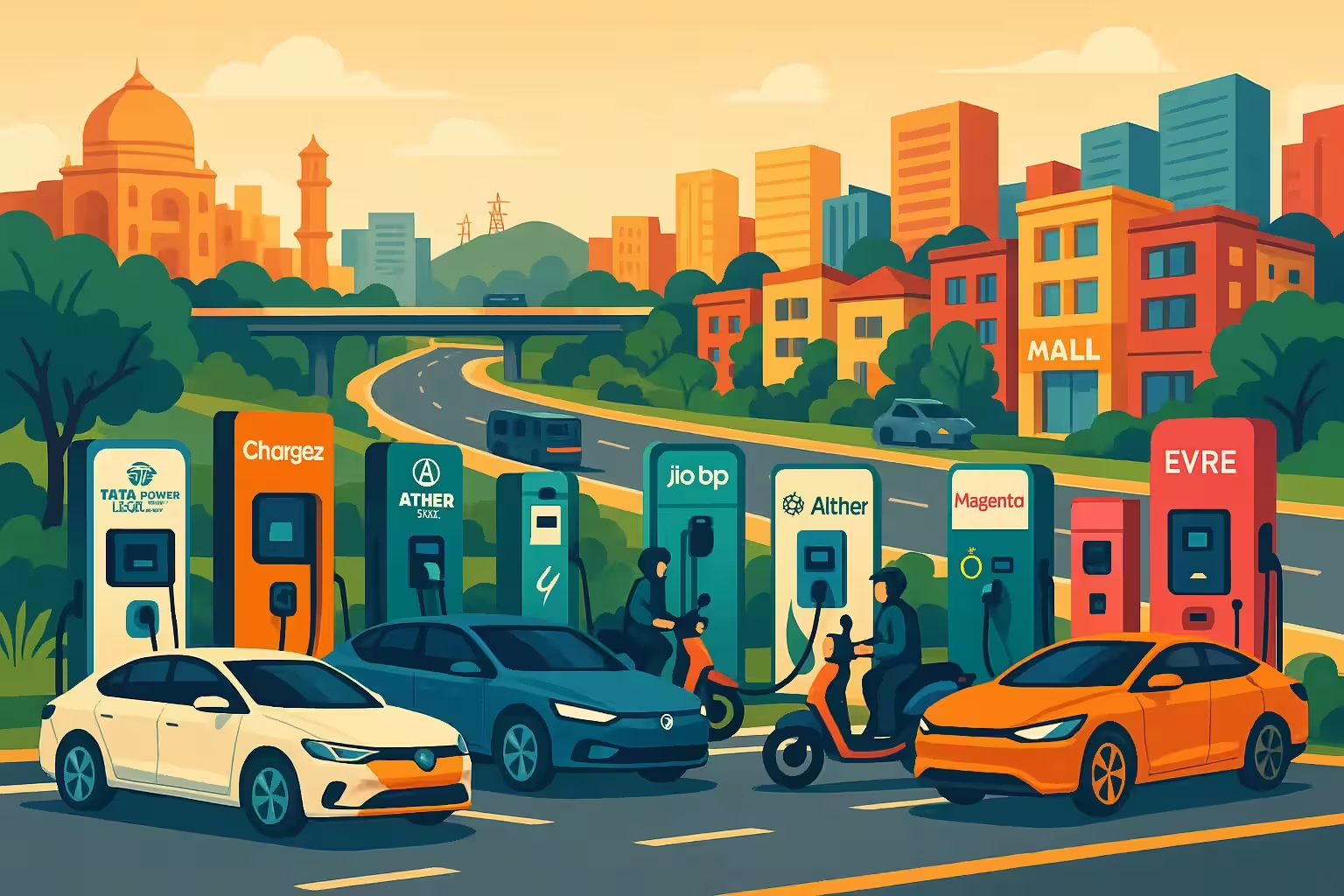
What Is Home Charging for Electric Vehicles in India and How Does It Work?
If you’re thinking about switching to an electric vehicle (EV) in India, one of the first things you’ll want to know is how to charge it at home. Home charging is the most convenient and cost-effective way to keep your EV ready for the road. In 2025, over 80% of Indian EV users prefer charging at home, according to the Society of Indian Automobile Manufacturers (SIAM).
Charging your EV at home simply means connecting your car to an electricity supply using either a regular power socket or a dedicated EV charger. The two main ways to do this in India are:
- Using a standard 15A power socket (the same type you use for air conditioners or geysers)
- Installing a dedicated EV wall box charger, which is faster and safer
You’ll need to have a parking spot close to a power supply, and an understanding of electricity safety protocols. Many carmakers offer home charger installation support as part of their EV packages.
Did You Know?
Home charging is about three times more affordable than public fast charging in most Indian cities as of 2025. Charging at home can cost less than ₹2 per km for popular EV models.
Why Should You Charge Your EV at Home in India?
Charging your EV at home brings a lot of benefits, especially for Indian users who may face unreliable public charging infrastructure in some cities.
Here’s why home charging stands out:
- Convenience: Plug in overnight, wake up to a fully charged car every morning.
- Cost Savings: Residential electricity tariffs are lower than fast-charging station rates in most states.
- Time-Saving: No need to wait at public charging stations or queue up during peak hours.
- Safety: Modern home chargers come with overload protection and safety certifications.
- Predictable Charging: You control when and how much you charge, reducing range anxiety.
- Government Incentives: Some states offer subsidies and lower tariffs for home charging, under the FAME II scheme and state-specific EV policies.
If you live in a metro or Tier-1 city, chances are your electricity provider and local EV dealership can help you set up a home charger within days.
Expert Insight
According to Tata Power, home charger installations in Indian metros grew by over 200% from 2022 to 2025, showing strong consumer trust in home charging.
What Types of Home Chargers Are Available in India in 2025?
There are two main types of home EV chargers you can choose from in India, each with its pros and cons:
1. Portable Chargers (Level 1)
- Plug into any 15A socket
- Charging Speed: 8–12 hours for a full charge (depends on battery size)
- Best For: Occasional users or those with limited parking space
2. Wall-Mounted Home Chargers (Level 2)
- Installed by professionals at your parking spot
- Charging Speed: 3–6 hours for a full charge
- Best For: Daily users, larger battery EVs, faster charging needs
Let’s compare top options available in 2025 for Indian EV owners:
| Charger Model | Type | Output Power | Compatibility | Installation Cost (₹) | Average Charging Time (0-100%) | Key Features |
|---|---|---|---|---|---|---|
| Tata Power EZ Charger | Level 2 | 7.2 kW | Most Indian EVs | 45,000 – 65,000 | 4–6 hours | Smart App, Safety Cutoff |
| Ather Dot | Level 2 | 3.3 kW | Ather, Tata, Ola, etc | 30,000 – 40,000 | 6–8 hours | Compact, Weatherproof |
| ABB Terra AC | Level 2 | 7.4 kW | All CCS2 EVs | 60,000 – 80,000 | 3–5 hours | Remote Monitoring |
| Magenta ChargeGrid | Level 2 | 7.4 kW | Universal | 42,000 – 65,000 | 4–6 hours | RFID, OCPP support |
| Delta AC Mini Plus | Level 2 | 7.4 kW | Universal | 50,000 – 70,000 | 4–5 hours | LCD Display, App Control |
| Exicom Harmony | Level 2 | 7.2 kW | Universal | 38,000 – 55,000 | 4–6 hours | Smart Metering, Alerts |
| Okaya Fast AC | Level 2 | 7.4 kW | Universal | 45,000 – 65,000 | 4–6 hours | Touchscreen, WiFi |
| Siemens VersiCharge | Level 2 | 7.2 kW | Universal | 60,000 – 90,000 | 4–6 hours | App, Voice Assistants |
| Bosch EV AC Charger | Level 2 | 7.4 kW | Universal | 55,000 – 80,000 | 4–5 hours | Durable, IP65 Rated |
| EVI Technologies e-Charge | Level 2 | 7.2 kW | Universal | 37,000 – 52,000 | 4–6 hours | Remote Diagnostics |
Key Details About Top 2025 Home Chargers
- Tata Power EZ Charger: Integrated with Tata EVs; offers seamless support and a mobile app for real-time status.
- Ather Dot: Favoured for its simple installation and compact design, especially in apartments.
- ABB Terra AC: Suitable for multiple EV users due to fast charging and cloud features.
- Magenta ChargeGrid: Known for customer support and OCPP (Open Charge Point Protocol) compliance, helping you future-proof your investment.
- Delta AC Mini Plus: Good for Indian weather conditions; has LCD for instant information.
- Exicom Harmony: Budget-friendly, with smart metering for accurate electricity tracking.
- Okaya Fast AC: Offers WiFi connectivity and touchscreen control.
- Siemens VersiCharge: High-end, loaded with voice assistant integration.
- Bosch EV AC Charger: Rugged and durable, best for outdoor installations.
- EVI Technologies e-Charge: Remote diagnostics and easy maintenance.
Did You Know?
In 2025, EV makers like Tata, MG, Hyundai, and Mahindra include home charger installation as part of their EV purchase package in most Indian cities.
How Much Does It Cost to Install and Use a Home Charger in India (2025)?
Home charging costs depend on the type of charger, installation complexity, your local electricity tariff, and your EV’s battery size.
Upfront Costs
- Basic Portable Charger: Usually free with most EVs
- Wall-Mounted Charger: ₹35,000 – ₹90,000 (including equipment + installation)
- Upgrading Electricity Connection: ₹10,000 – ₹25,000 (if required for higher power)
Running Costs
- Average Home Electricity Tariff (India, 2025): ₹6 to ₹9 per kWh (residential slabs)
- Average Full Charge (30–40 kWh battery): ₹180 – ₹360 per full charge
- Cost per KM: Typically ₹1.5 – ₹2.5 per km, depending on efficiency
Additional Costs
- Annual Maintenance: Minimal, about ₹1,000 (for cleaning and electrical checks)
- Spare Parts: Rarely needed, but replacement cables can cost ₹2,000 – ₹5,000
Typical Total First-Year Cost (2025)
| Item | Cost Range (₹) |
|---|---|
| Charger Equipment & Installation | 35,000 – 90,000 |
| Electricity for 12,000 km/year | 18,000 – 30,000 |
| Maintenance | 1,000 |
| Total | 54,000 – 1,21,000 |
Expert Insight
Delhi, Gujarat, and Maharashtra offer some of the lowest residential EV charging tariffs in India due to state government support in 2025.
Which Indian EVs Are Best Suited for Home Charging?
Most electric vehicles sold in India today are designed for easy home charging. Here are the most popular models in 2025 and how well they fit home charging setups:
| Model | Battery Size (kWh) | Home Charge Time (Level 2) | Compatible Chargers | Cost per Full Charge (₹) | Special Home Charging Features |
|---|---|---|---|---|---|
| Tata Nexon EV Max | 40.5 | 5–6 hours | Tata, Delta, Exicom | 280–360 | Tata Power Home Charger Support |
| MG ZS EV | 50.3 | 6–7 hours | MG, ABB, Delta | 350–450 | Free home charger installation |
| Hyundai Kona EV | 39.2 | 5–6 hours | Hyundai, Bosch, ABB | 300–370 | App-based monitoring |
| Mahindra XUV400 EV | 39.4 | 5–6 hours | Exicom, Tata, Okaya | 250–350 | Home charger as standard |
| BYD Atto 3 | 60.5 | 7–8 hours | BYD, ABB, Delta | 400–550 | High power home charger included |
| Tata Tiago EV | 24 | 3–4 hours | Tata, Ather, Magenta | 150–200 | Compact charger, easy to install |
| Citroen eC3 | 29.2 | 4–5 hours | Tata, Exicom, Okaya | 170–250 | Compact charger support |
| Renault Kwid EV* | 26 | 4–5 hours | Universal | 160–210 | Apartment-friendly installation |
| Ola S1 Pro (4W EV)* | 40 | 5–6 hours | Ola, Delta, Magenta | 200–300 | Smart charger with app |
| Honda Elevate EV* | 45 | 6–7 hours | Honda, Tata, ABB | 290–400 | Smart home charging package |
*New models launching 2025
Why These EVs Work Well for Indian Homes
- Tata Nexon/MG ZS/Hyundai Kona: Larger batteries but compatible with typical Indian home wiring and standard wall chargers.
- Tata Tiago/Citroen eC3: Smaller batteries, charge faster, ideal for city usage and apartments.
- BYD Atto 3: For those needing long range, BYD provides its own high-power charger.
- Ola S1 Pro/Honda Elevate EV: New for 2025, designed with compact, smart home charging in mind.
Did You Know?
Over 60% of Indian EV buyers rank “home charging compatibility” as their number one concern, ahead of price or range.
How Do You Get a Home Charger Installed in India (Step-by-Step in 2025)?
Getting a home charger is easier today than ever before. Most dealerships and third-party providers will help you with end-to-end installation.
Step-by-Step Guide
- Book Your EV: Choose a model; most brands offer bundled home charger support.
- Site Survey: Company technician visits your location to assess parking and power supply.
- Charger Selection: Choose basic or smart charger, depending on your usage.
- Electrical Upgrades (if needed): Installer may upgrade your wiring or circuit breaker.
- Charger Installation: Wall-mounted charger is fixed, tested for safety.
- Commissioning: You’re given a demo; app or RFID setup if provided.
- Government Registration (if needed): Some states require charger registration for subsidy claims.
- Charging Begins: Plug in your car and start using!
Tips for Hassle-Free Installation
- Pre-Installation: Get a no-obligation site survey from your EV dealer.
- Apartment Owners: Get society NOC (No Objection Certificate) as early as possible.
- Choose the Right Location: Covered, well-ventilated, close to your parking.
- Ask for Surge Protection: Especially in areas prone to voltage fluctuation.
Expert Insight
In 2025, over 75% of Indian housing societies in Tier-1 cities allow home EV charging, usually after a simple approval process.
What Are the Key Safety Tips for Home EV Charging in India?
Safety is crucial. Indian weather, monsoons, and local power surges make it important to take extra care.
Essential Safety Practices
- Certified Equipment: Always use ISI or BIS certified chargers, plugs, and cables.
- Professional Installation: Never DIY – let certified electricians handle the wiring.
- Earth Leakage Protection: Ensure your charger has an ELCB (Earth Leakage Circuit Breaker).
- Weatherproofing: Use chargers rated IP55 or above for outdoor use.
- Regular Checks: Inspect cables and sockets for wear or damage.
- Avoid Overloading: Don’t use extension cords or multi-plugs.
- Proper Earthing: Essential for Indian homes; ask your technician to check this.
- Child Safety: Ensure charging area is away from children and pets.
Monsoon Care
- Keep charger covered.
- Wipe cables dry before plugging/unplugging.
- Immediately report any sparking or unusual sounds.
Did You Know?
Modern wall box chargers have smart sensors that automatically cut off power if they detect overheating or water ingress.
When Is the Best Time to Charge Your EV at Home in India?
Timing your EV charging can help you save more and ensure grid stability.
Off-Peak Charging
- Nighttime (10 PM to 6 AM): Most states have lower tariffs during off-peak hours.
- Benefits: Lower costs, less strain on the grid, fully charged car by morning.
Peak Hour Avoidance
- Avoid plugging in between 6 PM and 10 PM unless necessary, as electricity rates can be higher.
Time-of-Day Tariffs (2025)
Some states (Delhi, Maharashtra, Karnataka) offer special “time of use” tariffs for EVs:
| State | Off-Peak Rate (₹/kWh) | Peak Rate (₹/kWh) |
|---|---|---|
| Delhi | 5.5 | 7.2 |
| Maharashtra | 6.0 | 8.0 |
| Karnataka | 6.2 | 8.5 |
Smart Charging
- Modern chargers let you schedule charging sessions via app.
- Some can even pause charging if the grid is overloaded.
Expert Insight
Several Indian DISCOMs (power companies) offer separate EV metering to help you track costs and get lower tariffs.
How Do You Charge Your EV in an Apartment or Shared Parking in India?
Living in an apartment doesn’t mean you can’t charge your EV at home. In 2025, more Indian high-rises and societies are actively supporting EV charging.
Steps for Apartment Charging
- Check Society Policy: Speak to your RWA or building management.
- Get NOC: Most require a written No Objection Certificate.
- Choose Charger Location: Ideally, your designated parking slot.
- Wiring: Dedicated line from your home meter; avoid using common area supply unless agreed.
- Shared Chargers: Some societies install shared chargers at common points (often app or RFID controlled).
Top Apartment Charging Solutions in 2025
- Ather Dot: Favoured for compact size.
- Magenta ChargeGrid: Offers shared charging and RFID access.
- Tata Power: Now partners with many societies for managed charging.
- Okaya Fast AC: Good for multi-user set-ups.
Tips for Smooth Apartment Charging
- Document Everything: Written approvals, wiring diagrams, and meter readings.
- Smart Meter: Ask for a separate sub-meter if possible.
- Community Charger: Great for smaller societies or where parking is limited.
- Charging Etiquette: Always unplug and keep the area tidy for your neighbours.
Did You Know?
The Indian government’s Model Building Byelaws 2025 recommend that all new apartments allocate at least 20% of parking spots for EV charging.
What Are Some Real User Experiences of Home EV Charging in India?
Let’s look at actual case studies to help you see the process and benefits.
Case Study 1: Rajesh, Pune – Tata Nexon EV Owner
- Setup: Lives in a standalone house, installed Tata Power home charger.
- Process: Dealer arranged survey and installation in 3 days.
- Experience: Charges overnight, spends ₹1.8/km; never uses public stations unless on highways.
- Challenge: Needed to upgrade his home meter – cost an extra ₹12,000.
Case Study 2: Sanjana, Bangalore – Hyundai Kona EV in Apartment
- Setup: Apartment parking, used Hyundai-approved Bosch charger.
- Process: Needed RWA approval; took 2 weeks for wiring.
- Experience: Society supportive, now considering a shared charger for other residents.
- Tip: Recommends documenting every step and using app-based chargers for easy monitoring.
Case Study 3: Ajay, Delhi – MG ZS EV in Gated Community
- Setup: Installed ABB Terra AC charger with society permission.
- Process: Installation done in one day, society now plans more chargers.
- Experience: Enjoys flat EV tariff of ₹5.5/kWh via special meter.
- Advice: Always check for available subsidies.
Expert Insight
EV owners in Indian metros report that the biggest benefit of home charging is the peace of mind it brings: “No more fuel station visits or range anxiety!”
Which Indian States Offer the Best Support for Home EV Charging in 2025?
EV adoption is rapidly growing in states that offer smart incentives for home charging.
Top States for Home Charging (2025)
- Delhi: Subsidies on chargers, lowest domestic EV tariff, hassle-free registration.
- Maharashtra: Up to ₹15,000 subsidy on home chargers, special feeder lines for societies.
- Karnataka: Discounts on installation, dedicated EV tariff slabs.
- Gujarat: Fastest approval for society and apartment charging.
- Kerala: State-level incentives for community chargers in apartments.
- Tamil Nadu: New buildings must have wiring for EV chargers as per 2025 byelaws.
- Telangana: Subsidies for both home and workplace chargers.
How States Support Home Charging
- Subsidy on Charger Cost: Rebate on purchase and installation.
- Tariff Discounts: Special EV rates, often 20-30% lower than standard.
- Fast-Track Approvals: Dedicated helplines and EV cells in power companies.
- Awareness Campaigns: Workshops and residential society tie-ups.
Notable Policies
- Delhi EV Policy 2025: Up to ₹6,000 subsidy per charging point for the first 30,000 points, fast online approval.
- Maharashtra EV Policy 2025: Additional incentives if you install community chargers in apartments.
Did You Know?
Over 70% of new residential societies in Mumbai and Bengaluru are now pre-wired for EV charging, as per the 2025 real estate guidelines.
How Can You Maximise Savings and Efficiency in Home EV Charging?
Charging smart means saving money and helping the environment too.
Tips to Maximise Savings
- Use Off-Peak Hours: Schedule charging at night for lowest tariffs.
- Install a Smart Charger: Lets you monitor and control usage via mobile app.
- Track Your Usage: Many chargers provide monthly reports – useful for budgeting.
- Check for Subsidies: Apply for rebates from state government or DISCOMs.
- Maintain Your Charger: Keep it clean and inspect regularly for maximum life.
Efficiency Boosters
- Solar Charging: If you have rooftop solar, connect it to your charger for almost free, green energy.
- Pre-Conditioning: Use your car’s app to heat/cool the cabin while plugged in, saving battery on the road.
- Avoid Full Drains: Regular small top-ups are better for battery health.
Environmental Impact
- Home charging emits 30–50% less CO₂ than petrol/diesel use in India, even with the current grid mix.
- Using solar or green power cuts emissions even more.
Expert Insight
In 2025, many Indian banks offer green loans for EV charger installation at low interest rates – ask your dealer for options.
Final Verdict: Should You Charge Your EV at Home in India in 2025?
If you want true convenience, savings, and peace of mind, home EV charging is the way to go in India in 2025. Here’s why:
- Most EVs and chargers are now designed for Indian homes and apartments.
- Government and power companies support home charging with subsidies, lower tariffs, and approvals.
- You avoid the hassles of public charging and get full control over your costs.
Whether you own a standalone home or live in an apartment, home charging is now accessible, affordable, and future-ready. Take the next step by booking a site survey with your EV dealer or a certified installer. With government support and growing infrastructure, there has never been a better time to plug into the electric revolution from your own home.
FAQs
Q1: Can I charge my electric car from a normal socket at home in India?
Yes, most EVs come with a portable charger compatible with a 15A socket, but it’s slower and less safe for daily use compared to a dedicated wall charger.
Q2: Do Indian housing societies allow home charging?
In 2025, most societies in major cities support home charging, but you’ll usually need to get written approval (NOC) and may have to follow specific wiring guidelines.
Q3: How do I apply for a government subsidy for my home EV charger?
Check your state EV policy. Submit your charger purchase and installation documents online or at your nearest DISCOM office, as per state procedure.
Q4: Will installing a home charger increase my electricity bill much?
Your bill will increase according to your EV’s usage, but per kilometer, it’s still much cheaper than petrol or diesel. Separate EV tariffs can help reduce costs.
Q5: What should I do if my home has frequent power cuts?
Consider a charger with surge protection and a battery backup. You may also schedule charging for times when power supply is most stable.
Disclaimer: All details, costs, and policies are based on the latest available information as of 2025. Always check with your local power provider or government portal for updates or specific regulations in your area.


